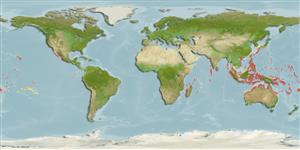Common names from other countries
Classification / Names / Names
Common names | Synonyms | Catalog of Fishes (gen., sp.) | ITIS | CoL | WoRMS
Environment: milieu / climate zone / depth range / distribution range
Ecology
Reef-associated; depth range 0 - 3 m (Ref. 8294). Tropical
Indo-West Pacific: West to Red Sea; north to southern Japan; east to Samoa; and south to New Caledonia.
Length at first maturity / Size / Weight / Age
Maturity: Lm ? range ? - ? cm Max length : 100.0 cm COLD male/unsexed; (Ref. 269)
Forms large colonies, more than 100 cm in diameter, that may be massive, or most commonly, composed of vertical branches or folia. The surface appearance is very smooth, and the color in life is a distinctive grey-brown with white tips. The entire skeleton is blue (Ref. 269).
Depth based from occurrence (Ref. 8294); to be replaced with a better reference. Most common in shallow water (Ref. 269), on reefs at typically less than 2 m. Also in exposed reef areas, reef flats and the intertidal zone (Ref. 98471).
Life cycle and mating behavior
Maturity | Reproduction | Spawning | Eggs | Fecundity | Larvae
Members of the class Anthozoa are either gonochoric or hermaphroditic. Mature gametes are shed into the coelenteron and spawned through the mouth. Life cycle: The zygote develops into a planktonic planula larva. Metamorphosis begins with early morphogenesis of tentacles, septa and pharynx before larval settlement on the aboral end.
Ross, M.A. and G. Hodgson. 1981. (Ref. 8294)
IUCN Red List Status (Ref. 130435)
CITES status (Ref. 108899)
Not Evaluated
Human uses
Fisheries: of potential interest
| FishSource |
Tools
Internet sources
Estimates based on models
Preferred temperature
(Ref.
115969): 25.1 - 29.3, mean 28.5 (based on 2158 cells).
Vulnerability
High vulnerability (60 of 100).
Price category
Unknown.
